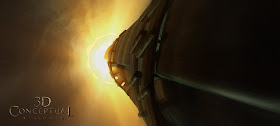Behind The Sketch: The Four Step Process
I am asked if I like sketching in the computer all the time, and the fact is that I am a traditional sketch artist trained during the time at Art Center when the Students only sketched on paper. I have a process that I have used for a few years and here is a basic breakdown.
The above sketch was done for Rand Miller up in Spokane WA back in the year 2000 when I was doing Conceptual Designs for the URU extension of the MYST worlds.[ What a FUN time that was!]
Supplies:
Indigo Blue Color-erase.
Indigo Blue Prismacolor.
Indigo Blue Markers.
8.5 x 11 Plain white Xerox Paper
8.5 x 11 Clear-print Drafting Velum.
Alvin Drafting Dots.
First Step:
I do a very rough freehand sketch blocking out the shapes and the basic proportions that will be in the design. I do this with a Colorerase Indigo Blue pencil on plain Xerox white paper. I have loved the Indigo Blue sketch technique since it was taught to us at Art Center but then we used Verithin and Prizmacolor. I now use color-erase, since it will actually erase well and I tend to push so hard I break the fragile leads in the Verithin pencils, and can "put an eye out".
Second Step:
I overlay the rough sketch with Velum using drafting dots on the back so I can slide the curves over the drawing and NOT catch the tape. I do this tight version over the top using french curves and ship curves so the majority of the sketch is done with templates, another technique that I have used since I saw Syd Mead paint using curves back in his studio in the mid eighties, I applied it to drawing. I then scan the image at a very High resolution as a 4K JPG.
Third Step:
I desaturate the image in Photoshop CS4 to remove the color and I stage the image with lighter and darker layers of the sketch and I paint between them to achieve a better staging with light ans shadows accentuated. Working in black and white allows you to see the value contrast better and not be distracted by color similar to B+W Photography.
Fourth Step:
I colorize the image into a family of color of choice, and as in the above case I also added a texture to the image as well.
The above sketch was done for Rand Miller up in Spokane WA back in the year 2000 when I was doing Conceptual Designs for the URU extension of the MYST worlds.[ What a FUN time that was!]
Supplies:
Indigo Blue Color-erase.
Indigo Blue Prismacolor.
Indigo Blue Markers.
8.5 x 11 Plain white Xerox Paper
8.5 x 11 Clear-print Drafting Velum.
Alvin Drafting Dots.
First Step:
I do a very rough freehand sketch blocking out the shapes and the basic proportions that will be in the design. I do this with a Colorerase Indigo Blue pencil on plain Xerox white paper. I have loved the Indigo Blue sketch technique since it was taught to us at Art Center but then we used Verithin and Prizmacolor. I now use color-erase, since it will actually erase well and I tend to push so hard I break the fragile leads in the Verithin pencils, and can "put an eye out".
Second Step:
I overlay the rough sketch with Velum using drafting dots on the back so I can slide the curves over the drawing and NOT catch the tape. I do this tight version over the top using french curves and ship curves so the majority of the sketch is done with templates, another technique that I have used since I saw Syd Mead paint using curves back in his studio in the mid eighties, I applied it to drawing. I then scan the image at a very High resolution as a 4K JPG.
Third Step:
I desaturate the image in Photoshop CS4 to remove the color and I stage the image with lighter and darker layers of the sketch and I paint between them to achieve a better staging with light ans shadows accentuated. Working in black and white allows you to see the value contrast better and not be distracted by color similar to B+W Photography.
Fourth Step:
I colorize the image into a family of color of choice, and as in the above case I also added a texture to the image as well.
Cheers, THOM






















































